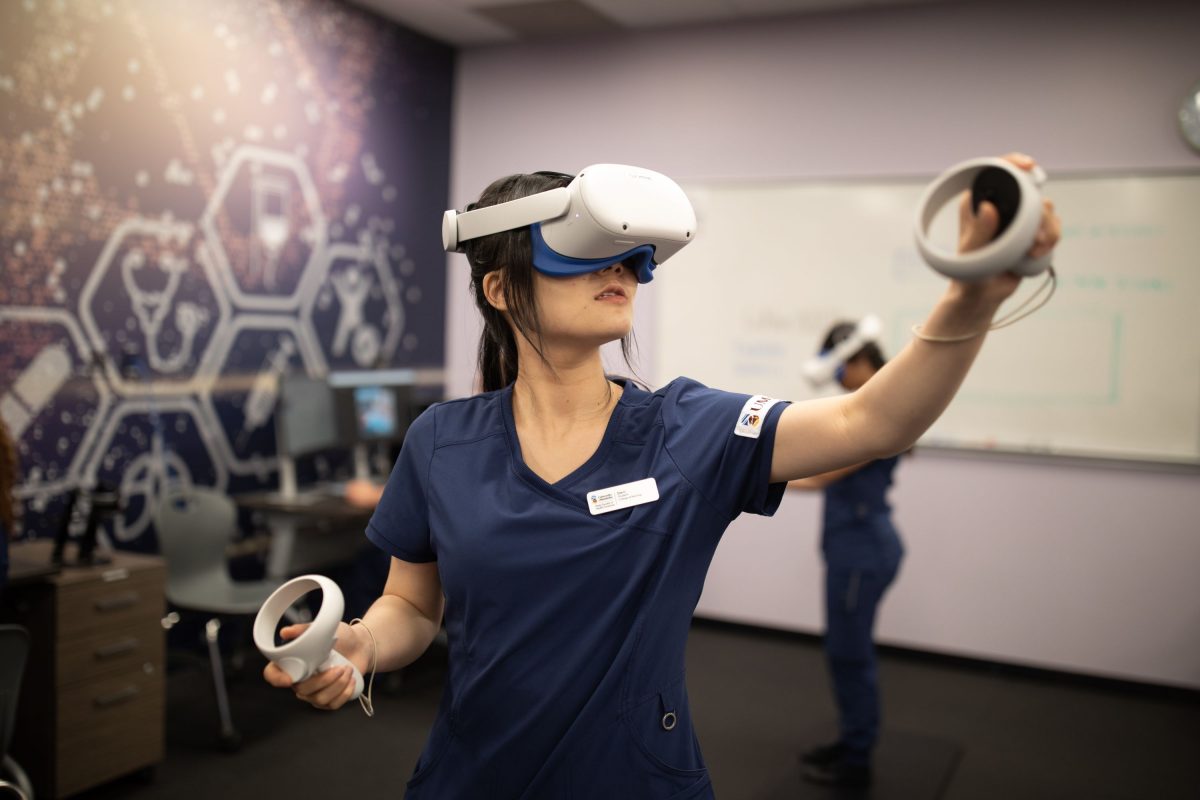
Virtual reality provides opportunities to teach skills like prioritization, problem solving and decision making in stressful environments.
Exploring virtual reality in teaching and learning
New technology provides space for collaboration, situational learning
The College of Nursing in the Rady Faculty of Health Sciences is a leader in simulation education among nursing faculties across the country. Now, they are extending their simulations with virtual reality.
Nicole Harder, associate professor in nursing and the Mindermar Professor in Human Simulation for the Rady Faculty of Health Sciences, says one of the newer opportunities in simulation education is virtual reality, which provides opportunities to teach things like prioritization, problem solving and clinical decision-making skills.
“We have a whole suite of learning opportunities, or simulation modalities, and it’s just about which is the right one for the skill that we’re trying to teach,” says Harder.
An added benefit is that students don’t need to be in the same physical space to have the same learning outcome.
Enhancing learning outcomes
“We have two satellite sites at University College of the North, so Thompson and The Pas, and we’ve just worked with them to get virtual reality going for them,” says Harder. “So now we’re going to be able to put students from the Fort Garry site and the University College of the North sites in the same virtual reality room to work on a clinical case together, which previously we weren’t able to do.”
The software allows up to four people to engage using headsets and upwards of 20 people as observers. People can log in from anywhere and watch what’s happening in a simulated emergency room, dentist’s office, or wherever the simulation has been designed to occur.
“There are questions and learning objectives for the observers, so they are not observing just for the sake of watching,” explains Harder. “Then we debrief it all together to see how we’ve been able to achieve our learning outcomes.”
Lawrence Gillman, associate professor in the Max Rady College of Medicine, is the director of the Clinical Learning and Simulation Program on the Bannatyne campus.
He says VR is great for teaching how to deal with critical conversations and stressful situations.
“When we do a medical emergency simulation, the focus is on the teamwork and the collaborative, non-technical skills – your leadership skills and your communication skills,” says Gillman. “The actual medical part of it is less important than the reality of just working together in a team and creating a stressful environment. That lends itself really well to VR because the look of things can be more realistic.”
Not only is VR useful for teaching stressful situations, it can also be used to expand knowledge about diagnostic tools like ultrasounds.
One of the issues with ultrasound is that it takes 3D anatomy and turns it into a 2D representation on a screen. It can then be hard to visualize how that 2D image corresponds to the structures in the body.
“By seeing it in VR,” says Gillman, “you can show students what they’re actually seeing on a human body, on the model, and then show them the ultrasound image and they can put those two things together.”
Gillman is also exploring opportunities to use VR as a surgical planning tool. He recently met with an anatomy company that can load CT scans into virtual reality and map out tumours and their relationships to important structures in a virtual space.
“We’re talking to our cancer surgeons about whether this is something that would be of interest to them because it gives you another way of visualizing the involved structures in 3D space,” says Gillman.
“The beauty of VR is we have the hardware, which works with multiple software platforms, so you can use it for multiple indications,” says Gillman. “Now we’re trying to figure out what those options are and who would be interested in them.”
Interprofessional collaboration
Harder and Gillman are part of a community of practice in the Rady Faculty of Health Sciences that is looking at expanding virtual reality into all the colleges: medicine, rehabilitation sciences, dentistry and pharmacy.
“We have a project where we are going to be creating interprofessional simulations for all of the Rady disciplines,” Harder explains.
“Here at the College of Nursing, we have a fairly robust VR program already. On Bannatyne they have a different structure,” she says. “We’re going to be creating a virtual reality ‘menu’ for the other colleges on Bannatyne and we are going to create a few that we think would work for all disciplines.
“And then in early spring, we want to have a bit of a technology fair or a ‘show and tell’ to demonstrate all the different ways you can use both virtual reality, as well as artificial intelligence, in interprofessional and intra-professional learning situations,” says Harder.
Learning together
Both Gillman and Harder are looking for partners in health sciences to explore how VR can be used in their programs. They are also interested in connecting with others in the university who are interested in VR.
Harder says having clear learning outcomes is essential if VR is to be a meaningful addition to an educational program.
“It has to be purposeful,” she says. “What are your objectives, why do you want to use this? And then think about if this is the right tool to do that.”
She recommends people interested in exploring VR reach out to someone who has experience incorporating it into their curriculum, to find out what opportunities exist.
“Let’s connect with other people who are using VR so we’re not reinventing the wheel all the time. Let’s share our experience, expertise and evaluation.”
The university is currently making ongoing efforts to its digital strategy and this article highlights how digital technology is improving our practices. Faculty and staff who are interested in engaging in discussions about digital best practices, technology and trends are invited to join the Digital Community of Practice.






